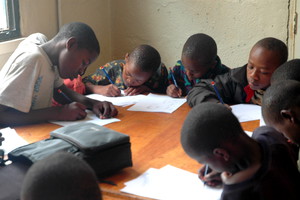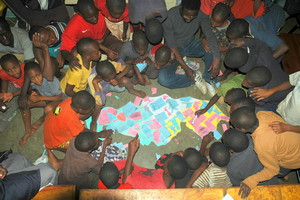Kenya: Centre Embarks on Empowering Street Children
By Eric Sande
 It is a chilly morning early on Wednesday and I decide to take a tour of Kibera, sub-Saharan Africa’s largest slum settlement. A pungent smell hits me as I crisscross the dusty terrain. I soon realize that the smell could be emanating from the ‘flying toilet’, a method most dwellers use to relieve themselves. I try to hold my breath but that doesn’t help as I have a long mission to accomplish.
It is a chilly morning early on Wednesday and I decide to take a tour of Kibera, sub-Saharan Africa’s largest slum settlement. A pungent smell hits me as I crisscross the dusty terrain. I soon realize that the smell could be emanating from the ‘flying toilet’, a method most dwellers use to relieve themselves. I try to hold my breath but that doesn’t help as I have a long mission to accomplish.
My first halt is at a rescue centre christened Ndugu Mdogo (Kiswahili for small brother). I am shocked at the overwhelming response accorded to me. Young children aged 5-14 come running to receive me awash with excitement. I try to imagine that they are excited after seeing the cameras I am carrying; perhaps they think I am here for a photo shoot. I suddenly find myself in high spirits due to the warm atmosphere.
Welcome to Ndugu Mdogo, a child rescue centre situated in the heart of Kibera. The centre launched its operations in September 2005 with an aim of promoting street interventions and youth empowerment programmes.
On the day of my visit, I found the children preparing for training. I quickly developed some interest to catch a glimpse of what was to transpire during the training and I was cordially absorbed in. I sat at the furthest corner and a hairy gentleman walked in. With his husky voice he introduced himself as Boniface Okada. He was the facilitator of the training.
The training started at exactly 10:00 am. The training’s theme was using art to express the rights of Children. Okada carried with him a copy of Kenya’s new Constitution. It quickly occurred to me that he was going to take the children through the new constitution.
“We are going to learn about the Constitution and your rights” said Okada. A silent mood immediately engulfed the four walls that were filled with enthusiastic spirits. One minute past and the children could be heard murmuring. One child stood up and said: “The constitution is meant for the older guys”.
Okada couldn’t hold his laughter, terming the boy’s suggestion as ridiculous. In his response, he clarified to the boys that it was for that reason that he came to teach them on their rights based on the current Constitution.
The class session went on well with the children being taken through their right to life, right to identity, right to shelter and right for care and protection . As lunch time approached, Okada called for a break.
The afternoon session was more practical in nature. Creative arts took centre stage; the children’s task was to interpret the morning theory class into drawings. The aim was to help them memorise their rights as enshrined in the Constitution.
It was interesting to see their pieces of work after an hour’s drawing session. Some drew the school to indicate the rights to education, while others drew houses to refer to the rights to shelter. Majority drew a man and a woman to represent care and protection and the church for the rights to worship.
It was an incredible experience and the class concluded with the children sticking their drawings on a map of Kibera. They carried the map all over the class singing with shrill voices that sounded innocent: “Kibera for peace.”
Article 14 (4) of the Constitution states that: "A child found in Kenya who is or appears to be less than eight years of age, and whose nationality and parents are not known, is presumed to be a citizen by birth".
Under the Kenyan Children’s Act, one of the particular rights of children is the right to a name and nationality, which facilitates their enjoyment of other rights.
Street children in Kenya face numerous hardships and danger in their daily lives. In addition to the hazards of living on the street, these children face harassment and abuse from the police and within the juvenile justice system for no reason other than the fact that they are street children. Living outside the protection of responsible adults, street children are easy and silent targets for abuse by police and society at large. On the streets, they are subject to frequent beatings by police as well as monetary extortion and sexual abuse. They are subject to frequent arrests simply because they are homeless.
Sadly enough, it is the harassment and negative adult reactions, not their hunger that troubles street children the most. Isolation and distrust cause them the greatest pain.
The advent of the new constitution provides for the rights of the minorities. This in simple terms gives the street children a sense of belonging.

Article 33 of Chapter 4 asserts the freedom of expression, including the right to seek, receive and impart information and ideas, the freedom of artistic creativity, academic freedom and the freedom of scientific research.
The majority of the children would not wish to continue with street life if given an alternative. According to The African Network for the Prevention and Protection against Child Abuse and Neglect (ANPPCANN) study, 77 per cent reported that they would not wish to continue with street life, while only 23 per cent wished to continue with street life.
Various reasons were given to justify why the majority of them would wish to discontinue with street life. They included the fact that street life is bad and tiring, the desire for a better life and the desire to go to school and to enjoy other conveniences elsewhere.
The mission to get the street children know their rights was a collaborative effort of the centre’s management and Koinonia Action for Peace, an NGO based in Kenya.



